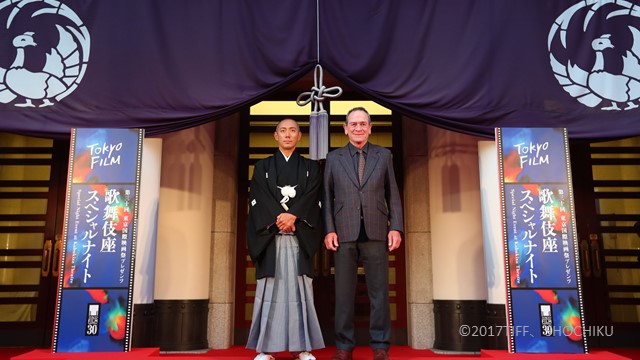
Schedule
Tickets
MarketOutline

The highlight of TIFF’s Japanese Classics section is undeniably the Special Night Event at the Kabukiza Theatre. This year’s evening, marking the fourth annual collaboration between TIFF and Shochiku as well as TIFF’s 30th anniversary, promised to be a singular one indeed.
The formally attired crowd of international and local visitors who arrived on October 26th in Higashi Ginza were clearly eager to experience the unique combination of classic film and classic theater.
But first, they were given a special treat: Kabuki stalwart Ichikawa Ebizo XI emerged from the historic Kabukiza Theatre to greet visitors before the festivities began. The tremendously popular actor is renowned not only for his mastery of the traditional performance art, but also for his work on television, in film (Ask This of Rikyu, Over My Dead Body) and contemporary theater. He is a passionate advocate for bringing Kabuki to younger audiences, as well as to overseas audiences, and he has performed in a variety of productions around the world.
Chatting in front of the theater with TV and radio personality Chris Peppler, who credited Ebizo with bringing the beautiful weather, the actor told the press, “I will be performing in ‘Otokodate Hana no Yoshiwara,’ which features a glamourous and appealing protagonist. There are bound to be many first-timers in the audience tonight, and there may be linguistic challenges. But I believe theater can touch your heart, and you can look forward to a unique experience. Kabuki has many formalities, just as opera and ballet do, but please enjoy the Japanese nagauta music and imagine yourselves time- slipping back to the Edo period.”
Ebizo was then joined by a surprise guest: TIFF International Competition Jury President Tommy Lee Jones, who surprised onlookers by bowing politely before joining the Kabuki actor on the dais, and bowed once again when he descended.
A little later, Peppler greeted the audience in the theater, and provided some historical context not only for the beautiful Kabukiza building, but also for the theatrical form. To the amusement of everyone, he also explained that the special obento boxes provided to guests were nicknamed after the character to be performed by Ebizo, and that the boxes were “filled with the taste of autumn.”
Then the lights went down, and the audience was treated to the 4K digitally restored version of the magnificent Gate of Hell, the 1953 masterpiece by Teinosuke Kinugasa. Filmed in Eastmancolor, the gloriously hued jidaigeki period piece was Daiei Film’s first color film and the first Japanese color film to be released outside Japan.
Gate of Hell tells the tragic story of a 12th-century samurai (Kazuo Hasegawa) who becomes obsessed with a noblewoman (Machiko Kyo) whom he rescues during a rebellion, only to discover that she is already married to someone else. This little fact does not stop him in his repeated attempts to win her away, however, and when her husband (Isao Yamagata) refuses to engage in violence with him, he takes matters into his own hands, twisting the fates of all three.
Kinugasa creates a world of unparalleled beauty, contrasting the ferocity of the samurai’s willfulness with the selflessness of a devoted couple in a loving marriage. When Gate of Hell won the Palme d’Or at the 1954 Cannes Film Festival, jury president Jean Cocteau called it “the pinnacle of beauty.” The masterwork went on to win 1955 Academy Awards for Best Foreign Language Film and Best Costume Design, among a plethora of other honors.
At that time, New York Times film critic Bosley Crowther wrote memorably, “The secret, perhaps, of its rare excitement is the subtlety with which it blends a subterranean flood of hot emotions with the most magnificent flow of surface serenity. The tensions and agonies of violent passions are made to seethe behind a splendid silken screen of stern formality, dignity, self-discipline and sublime esthetic harmonies. The very essence of ancient Japanese culture is rendered a tangible stimulant in this film.”
Following The Gate of Hell, the evening’s live performance of “Otokodate Hana no Yoshiwara”
began with the swishing back of the Kabukiza’s famous striped curtain, revealing a stunning street scene in the Yoshiwara pleasure district of Tokyo during the Edo period (1603-1868). With an endless line of geisha houses and an enormous cherry tree blossoming in the foreground, a kimono-clad woman danced delightedly in Nihon Buyo style, holding a black lacquer box in her hand. This was soon revealed to contain a letter, which she was sent to deliver by her mistress, the courtesan Keisei, to Keisei’s lover, Goshono Gorozo.
As Gorozo, Ebizo soon made a most extraordinary entrance, striding down the hanamichi central walkway from the back of the theater to the stage, the very picture of a chivalrous and self-satisfied young gallant (in actuality, he’s a samurai who has become a yakuza gangster). In his exaggerated kumadori makeup, Ebizo demonstrated the eye-crossing, head-circling mie glares that the role is made to showcase, provoking frequent applause.
Gorozo receives the letter from the delivery woman, but as he hastens to his love in Fujiwara, he is ambushed by a dozen or so men, dispatched by their masters to take revenge on him. As the stage erupted into an extended frenzy of jumping, flipping, umbrella- and sword-thrusting acrobatics — all of his dazzling and humorous — Gorozo effortlessly fended them off. And then, as the applause for Ebizo and his talented costars grew ever louder, the proud young gallant strode off, continuing on his way to his beloved in Yoshiwara.